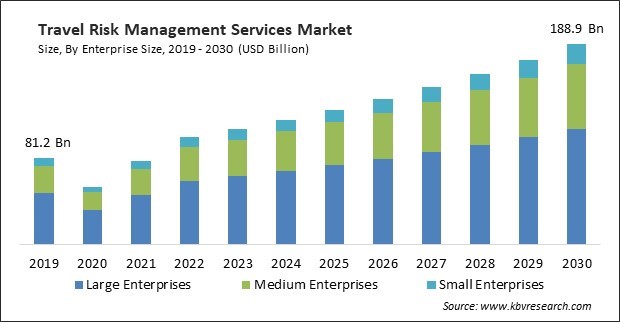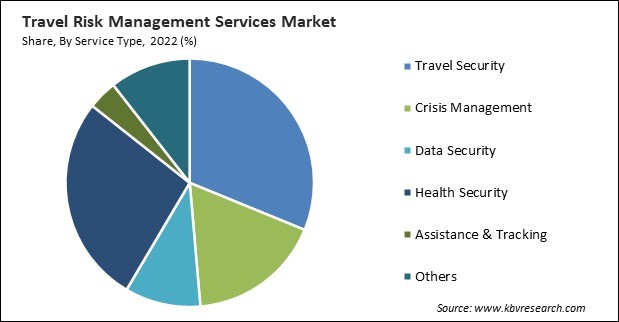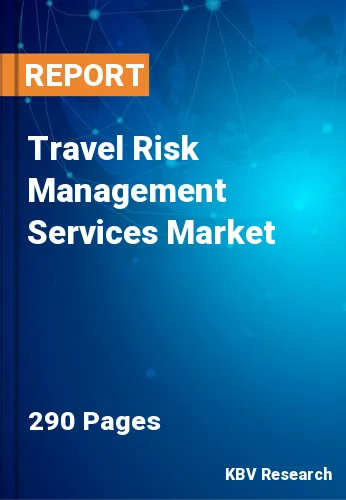The Global Travel Risk Management Services Market size is expected to reach $188.9 billion by 2030, rising at a market growth of 8.1% CAGR during the forecast period.
North America has numerous travel risk management service providers, ranging from large multinational corporations to specialized firms catering to specific industries or niches. These providers offer a wide range of services to meet clients' diverse needs. Therefore, the North America region would register more than 28% share of the market by 2030. The region has significant business travel due to its robust economy and global business ties. Travel risk management services ensure the safety and security of employees traveling for work attending meetings, conferences, and other business-related activities. Some of the factors impacting the market are rising awareness of travel risks, increasing frequency of natural disasters, and complex regulatory environment.

Increasing awareness of various travel risks, including health-related issues (e.g., pandemics), security threats, natural disasters, and political instability, has prompted organizations to prioritize traveler safety. High-profile events, including natural disasters, terrorist attacks, political unrest, and health crises like the COVID-19 pandemic have garnered extensive media coverage. These events have heightened public and organizational awareness of the risks associated with travel. Travelers and organizations are increasingly proactive in seeking solutions to mitigate and manage these risks, resulting in the growth of the market. Additionally, Travel risk management services specialize in assessing and mitigating travel-related risks, including those posed by natural disasters. They provide organizations valuable insights and recommendations to minimize exposure to such risks. These services help organizations develop and implement emergency evacuation plans for travelers in disaster-prone areas. This includes identifying safe evacuation routes and assembly points. The increasing frequency of natural disasters underscores the importance of these services. Organizations recognize the need to proactively address the risks associated with natural disasters to protect their employees, maintain business continuity, and demonstrate their commitment to duty of care. As natural disasters continue to pose challenges, the demand for comprehensive travel risk management solutions is expected to grow.
However, Organizations can face legal liabilities if they do not adequately fulfill their duty of care obligations. Understanding the legal implications of travel risk management is crucial. Regulatory authorities require organizations to monitor and report on their travel risk management practices. This involves tracking traveler data, risk assessments, and incident responses. These regulatory challenges require a thorough understanding of the legal requirements in different jurisdictions, proactive compliance measures, and ongoing monitoring of regulatory developments. The complex regulatory environment poses significant challenges to the market.
By service type, the market is categorized into travel security, crisis management, assistance & tracking, data security, health security, and others. In 2022, the travel security segment held the highest revenue share in the market. Travel risk management services often include tracking and monitoring capabilities. This involves using technology to monitor travelers' whereabouts and provide real-time updates on their locations. This allows organizations to know the whereabouts of their employees and respond quickly in case of emergencies. Providers offer comprehensive risk assessment services that analyze various factors, including destination safety, political stability, health risks, and crime rates. They use this information to provide travelers and organizations with intelligence reports and threat assessments.

Based on enterprise size, the market is classified into small enterprises, medium enterprises, and large enterprises. The medium enterprises segment acquired a substantial revenue share in the market in 2022. Medium-sized enterprises represent a growing and dynamic segment of the market. Their increasing global presence and business travel needs drive demand for travel risk management services. Medium-sized enterprises are a significant and growing customer segment in the travel risk management services market. Their demand for comprehensive, cost-effective, and customizable solutions contributes to this industry's continued expansion and development. As SMEs expand their global footprint, their reliance on travel risk management services is expected to increase.
On the basis of industry, the market is divided into pharmaceutical & healthcare, agri, food & beverage, hospitality, business services & consulting, IT, technology & telecom, and others. In 2022, the pharmaceutical and healthcare segment garnered a promising growth rate in the tra market. Pharmaceutical companies and healthcare organizations often have global operations, with employees and representatives traveling globally for various purposes, such as research, clinical trials, business meetings, and medical conferences. This extensive travel activity increases the demand for travel risk management services.
| Report Attribute | Details |
|---|---|
| Market size value in 2022 | USD 101.3 Billion |
| Market size forecast in 2030 | USD 188.9 Billion |
| Base Year | 2022 |
| Historical Period | 2019 to 2021 |
| Forecast Period | 2023 to 2030 |
| Revenue Growth Rate | CAGR of 8.1% from 2023 to 2030 |
| Number of Pages | 290 |
| Number of Table | 410 |
| Report coverage | Market Trends, Revenue Estimation and Forecast, Segmentation Analysis, Regional and Country Breakdown, Companies Strategic Developments, Company Profiling |
| Segments covered | Service Type, Enterprise Size, Industry, Region |
| Country scope | US, Canada, Mexico, Germany, UK, France, Russia, Spain, Italy, China, Japan, India, South Korea, Singapore, Malaysia, Brazil, Argentina, UAE, Saudi Arabia, South Africa, Nigeria |
| Growth Drivers |
|
| Restraints |
|
Region-wise, the market is analysed across North America, Europe, Asia Pacific, and LAMEA. In 2022, the Asia Pacific region led the market by generating the highest revenue share. The Asia Pacific region is one of the fastest-growing economic regions globally, with many countries experiencing rapid development. This growth has led to increased business travel, both domestically and globally. The Asia-Pacific region is a well-liked travel destination globally. Travelers, including tourists and business travelers, seek safety and security during their visits, fueling the demand for risk management services. The Asia Pacific region has embraced technological advancements, including mobile apps, GPS tracking, and communication platforms, which enhance traveler safety and communication.
Free Valuable Insights: Global Travel Risk Management Services Market size to reach USD 188.9 Billion by 2030
The market research report covers the analysis of key stake holders of the market. Key companies profiled in the report include FocusPoint International, Inc., BCD Group, Collinson International Limited, Tokio Marine Holdings, Inc., CWT Global B.V, Global Rescue LLC, Everbridge, Inc, Kroll, LLC, Chubb Limited, and Healix Group of companies.
By Service Type
By Enterprise Size
By Industry
By Geography
This Market size is expected to reach $188.9 billion by 2030.
Rising awareness of travel risks are driving the Market in coming years, however, Complex regulatory environment restraints the growth of the Market.
FocusPoint International, Inc., BCD Group, Collinson International Limited, Tokio Marine Holdings, Inc., CWT Global B.V, Global Rescue LLC, Everbridge, Inc, Kroll, LLC, Chubb Limited, and Healix Group of companies.
The IT, Technology & Telecom segment has shown the high growth rate of 7.6% during (2023 - 2030).
The Large Enterprises segment is leading the Market by Enterprise Size in 2022 thereby, achieving a market value of $109.3 BAillion by 2030.
The Asia Pacific region dominated the Market by Region in 2022, and would continue to be a dominant market till 2030; thereby, achieving a market value of $74.2 Billion by 2030.
Our team of dedicated experts can provide you with attractive expansion opportunities for your business.

